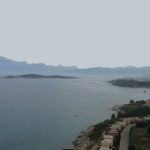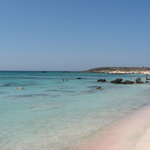Myths and History
Published on: 2012-07-30 23:15:57
A summary of the most important periods of Crete.
Cretan Myths
Zeus was born in Idaion Andron near the top of Psiloreitis mountain. He then was nurtured by the goat Amalthia in Diktaion Andron at Lasithi Plateau while the Mythical Kourites were banging their shields to cover the crying of baby Zeus from his father Cronus.
Zeus was transformed into a white bull and abducted the Phoenician queen Europe. He brought her to Crete and they mated under the Plane Tree at Gortys which remains evergreen since then. Europe gave birth to Minoas, Radamanthys and Sarpidon. Zeus gave her as a present the copper giant Talos, who surveilled Crete and threw rocks at the enemies.
Poseidon punished Minoas because of his disobedience to sacrifice a white bull the god offered him, by causing his wife Pasifai to fell in love with the bull. Daedalus assisted her to mate with the bull and she gave birth to Minotaur. Daedalus was ordered to build a Labyrinth where Minotaur lived till he was killed by the Athenean king Theseus. Theseus was helped by Ariadne exit Labyrinth with her Mitos (thread). Daedalus and his son Icarus flew away from Crete with wings made of feathers and wax, but Icarus flew close to the sun, the wax melted and he drowned into the sea.
Consice Cretan History
Carvings depicting dears, bows and arrows in the cave Asfendos (Sfakia) prove that around 8000BC the island was inhabited and Palaeolithic tribes existed in the mountains of the surrounding area. Small tools and equipment discovered in the coastal area between Tritipi and Rousses in Heraklion were used by a later civilisation. During the Neolithic Times, which spanned between 6000BC and 3000BC Knossos area was the most prominent, followed by Faistos, Plativolas (Keramia, Hania), Gerani (Rethymno) and Miamou (Lendas area). The Cycladic art has influenced the Cretan civilisation of the time due to their close commercial relationships. Settlements flourished also in Vasiliki and Gournia (Lasithi).
The Minoan civilisation expanded over 1500 years since 3000BC. Pre-Minoan, Minoan and Late-Minoan phases are discovered when studying the findings of the various settlements and towns. The golden age was the Minoan Period, when all major Palaces were built. The Minoans was a peaceful, merchant and well organised folk. They had a large fleet and traded with remote lands. A local King or Lord ruled settlements, and city-states was the system of government. Knossos Palace was very complicatedly built in several levels, with corridors, theatre, yard, citadels and a water and waste management system that was unique at the time. Labyrinth is said to be the Palace itself, due to its complicated architecture, while the Bull Leaping and the resulting death of some athletes created the myth about Minotaur eating young people. Earthquakes, wars with the Achaeans and the explosion of Santorini volcano led to the extinction of the civilisation.
The Achaeans conquered the island, developed studies and scripts while at the same time re-established commercial relationships with the Egyptians and the Minor Asia states. At that time, Crete under the ruling of King Idomeneas took part in the Trojan War. Physical disasters kept occurring and the civilisation declined, ending up as pirates.
Around 1000BC the Doreans took over the island with minimum effort. Indigenous Cretans (Eteocretans) were forced to evacuate towns and concentrated on the Lasithi mountains, at the area of Praisos. Towns increased in number (Gortys, Kydonia, Tilissos, Eleftherna, Lappa, Lissos, Praisos, Olunda), new productive methods (use of iron) and customs were introduced, the Law Code of Gortys was implemented while initially the arts such as sculpture and ceramic were flourishing till 5th century BC. Shortly before the Romans controlled the island (67BC), the city-states of Crete were fighting each other and supporting different kings of the ancient Greece.
During the Roman Times, Gortys was named the capital of the island and the town became a large scale settlement, with all amenities that large roman cities had, such as temples, auditoriums, stadiums and baths. At the time the population rose to 300000 people. Important towns were also Knossos, Kydonia, Aptera, Ierapetra, Faistos, Lyttos and Eleftherna. Christian religion was introduced and widely spread by Apostle Paul and his student Saint Titus.
Already Christians, the Cretans were officially part of the Byzantine Empire in 395AD under the reign of Theodosios. At Gortys the first Basilica on Crete was built, St Titus Basilica. Remains of Basilicas of that period exist in Itanos, Panormos and Almyrida. The attacks of Arabs (Saracens) were continuous till 824AD when the island was fallen to them.
The name Saracens meant those that did not originate from Sara (an important island of the time), but they originated from Agar, therefore they were also named by the Greeks as Agarens. They stayed on the island till 961AD, when the Byzantine General Nikiforos Fokas took the island back. In the meantime, they demolished Gortys, built a new capital where Heraklion is situated, constructed a large moat (Handaks in greek) and named the town El Khandak. From there they attacked all close and remote lands. Nikiforos Fokas fought 9 months to conquer El Khandak. The Cretans, already Christians, welcomed the Byzantine ruling and monasteries (following the Mount Athos establishment) were built.
After 1204, when Crusaders conquered Konstantinoupolis, Crete fall into the hands of the Gevones and it was consequently sold to the Venetians. Since 1212 they were established on the island, named Heraklion their capital and expanded largely their trade of cereals, olive oil and wine with other countries. At that time the arts were flourishing and the influence of the Venetian civilisation was evident. Well known Cretans were Dominicos Theotokopoulos (El Greco), Georgios Hortatzis (wrote Erofili play) and Vintsentzos Kornaros (wrote Erotokritos play). The Venetians saw in Crete an everlasting source of income and secured the island by building many fortresses, bastions and thick walls. Well preserved are the Walls in Heraklion and Fortezza in Rethymnon. All these were done by applying forced labour.
The Ottomans wanted to get that golden island and starting in 1645 they conquered one by one all major towns. First fell Hania, shortly afterwards Rethymnon and Heraklion took 21 years to fall. The population of the island decreased from 500000 to 50000 inhabitants, due to the large-scale battles, since Cretans kept fighting the Ottomans even after the fall of Heraklion. In Sfakia the area never fall into the hands of the Ottomans. It was there in 1821, that the revolution was established. Due to their strong courage, the Cretans won battles and forced the Ottomans to ask assistance from the Egyptians. At the same time the revolution was all over Greece and the Egyptians fought for 3 years solely on Crete, therefore the Greek Revolution was more successful in the rest of Greece. In 1831 Crete was offered by the Ottomans to the Egyptians. Cretans kept fighting and rebelled constantly not only against Ottomans but also against all rulers that the Allies imposed at the time. In 1866 after the explosion of the gunpowder citadel in Arkadi and the consequent sacrifice of the Cretans, the free Greeks helped the Cretans in the battles till the declaration of Crete in 1898 as an independent Cretan State took place.
In Therisso in 1905 a revolution against the improper ruling of Prince Georgios forced the Prince to withdraw. Eleftherios Venizelos, who was the leader of the revolution, worked towards the unification of Crete with Greece which took place in 1913.
The Cretans were always eager to assist in all Wars that Greece went into. Many Cretans were enrolled to fight in World War I, the Balkan Wars and the Minor Asia military campaign. In 1941 the German Parachuters (Luftwaffe) met a strong resistance from Cretans in Maleme for 10 days. The Battle of Crete helped the allies reorganise, while there was severe damage to the Germans. The occupation of Crete took 4 years, battles were frequent, while the Holocaust of Viannos and Kandanos are the cruellest acts of violence of the Germans.

